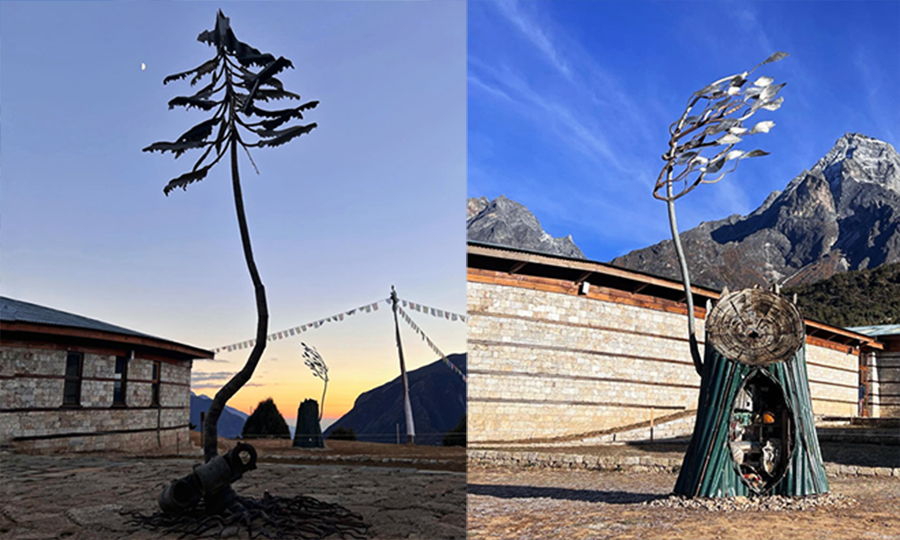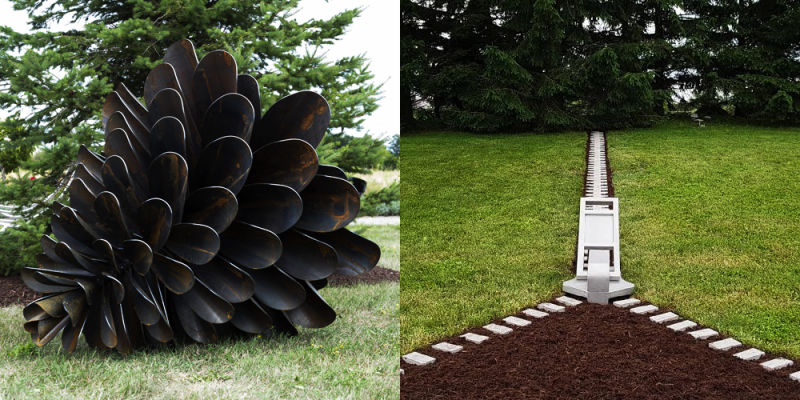Niagara Metal Artist, Floyd Elzinga Creates Sculptures out of Waste in Nepal

Established Canadian metal sculptor, Floyd Elzinga and his team, (Jeff Buikema and Carolyn Elzinga) have recently concluded a one-month art residency at Sagarmatha Next Center, in the Mount Everest region in Nepal. There, Elzinga has been transforming mountain waste into art and design, bringing innovation and sustainable solutions for solid waste management for trekkers, climbers, and the local Himalayan people. The aim of this non-profit collaboration with Sagarmatha Next and the Denali Foundation, is to bring necessary changes to the perception around waste by inviting international and local artists to create upcycled art and to provide a crowdsourced waste removal system where everyone can be part of the solution.
"The artwork creations made from collected waste materials by Floyd and his team have set a new high standard of innovative and creative reuse of waste materials. It has also contributed not only to set an artistic excellence level for our facility, but has also added invaluable support for our environmental preservation efforts to protect the unique natural beauty of the Mount Everest region for future generations. We are always very grateful and appreciative of Floyd Elzinga and his team’s passionate commitment to support Sagarmatha Next and the vision of a waste-free Mount Everest region and we thank him and his team from the bottom of our hearts.” Tommy Gustafsson
Elzinga is well-known for his unique indoor and outdoor steel and bronze sculptures that merge iconic imagery from the Canadian landscape. Walking through Oeno Gallery's Sculpture Garden, you will surely notice Elzinga's large-scale pinecones hand forged from weathering steel, or perhaps the oversized steel zipper that gives the illusion of 'unzipping the hillside'.
Elzinga's work at OENO GALLERY's Sculpture Garden —

Explore more works by Floyd Elzinga
Now, surrounded by mountains, Elzinga's new monumental pieces contribute towards a vision of a waste-free Mount Everest region. The three larger sculptures the team created (GROUNDED: THE WEIGHT OF FLIGHT, HOPE & RENEWAL) are monumental pieces that draw curious visitors, guides, and locals into the center. These sculptures, created in the Waste Lab at Sagarmatha Next, were sourced from scrap metal at several local waste pits. This scrap metal waste was dominantly produced from local households, construction waste, and pieces from several mountain climbing base camps. It included everything from helicopter parts (a 2003 MI-17 Russian plane crash at Everest) to household appliances, rebar, roofing material, and more. Although these sculptures are jarringly incongruous in the beautiful mountainscape, they offer the viewer a chance to reflect on both the brokenness of the past and the persistent hope for the future glimpsed in the new resilient growth.

“The hardest thing for me to do on this residency was to leave and come back to Canada...I felt like I had so much more that I wanted to do. I am ecstatic that the work I created and left there has resonated and inspired local artists and creators to make artwork out of waste. I am happy to be a part of the Everest Base Camp trekking route cleanup and waste reduction education campaign. I look forward to seeing how this movement grows.” Floyd Elzinga